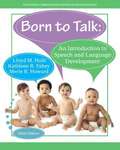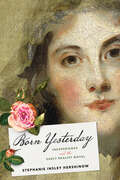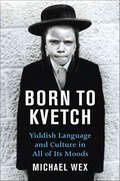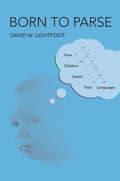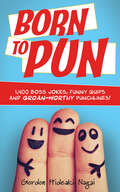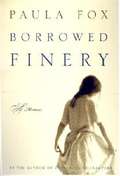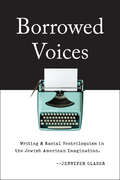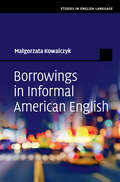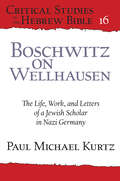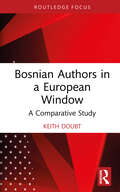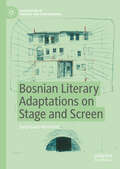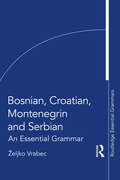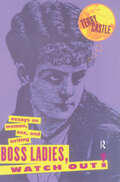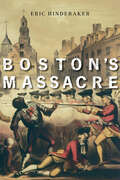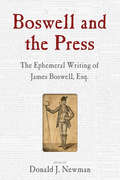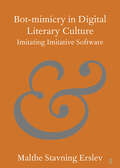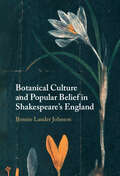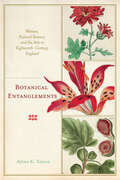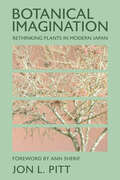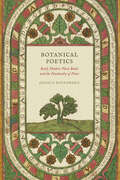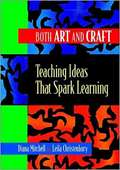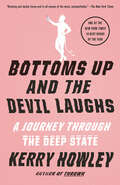- Table View
- List View
Born To Talk: An Introduction to Speech and Language Development (Sixth Edition)
by Lloyd M. Hulit Kathleen R. Fahey Merle R. HowardNOTE: Used books, rentals, and purchases made outside of Pearson If purchasing or renting from companies other than Pearson, the access codes for the Enhanced Pearson eText may not be included, may be incorrect, or may be previously redeemed. Check with the seller before completing your purchase. This package includes the Enhanced Pearson eText and the loose-leaf version With its primary focus on language development, Born to Talk, 6/e provides a comprehensive, contemporary, reader-friendly look at the many new and exciting contributions to the information about human language acquisition. In it, readers keep informed of the complex array of topics that provide the foundation for human communication and its development from birth through young adulthood. It is the ideal resource for students and practitioners in speech-language pathology, early childhood education, general education, special education, and related disciplines. The Enhanced Pearson eText features embedded video to illustrate key concepts and pop-up assessments to help students assess their proficiency. Improve mastery and retention with the Enhanced Pearson eText* The Enhanced Pearson eText provides a rich, interactive learning environment designed to improve student mastery of content. The Enhanced Pearson eText is: Engaging. The new interactive, multimedia learning features were developed by the authors and other subject-matter experts to deepen and enrich the learning experience. Convenient. Enjoy instant online access from your computer or download the Pearson eText App to read on or offline on your iPad#65533; and Android#65533; tablet. * Affordable. Experience the advantages of the Enhanced Pearson eText along with all the benefits of print for 40% to 50% less than a print bound book. *The Enhanced eText features are only available in the Pearson eText format. They are not available in third-party eTexts or downloads. *The Pearson eText App is available on Google Play and in the App Store. It requires Android OS 3. 1-4, a 7" or 10" tablet, or iPad iOS 5. 0 or later.
Born Yesterday: Inexperience and the Early Realist Novel
by Stephanie Insley HershinowThe early novel was not the coming-of-age story we know today—eighteenth-century adolescent protagonists remained in a constant state of arrested development, never truly maturing.Between the emergence of the realist novel in the early eighteenth century and the novel's subsequent alignment with self-improvement a century later lies a significant moment when novelistic characters were unlikely to mature in any meaningful way. That adolescent protagonists poised on the cusp of adulthood resisted a headlong tumble into maturity through the workings of plot reveals a curious literary and philosophical counter-tradition in the history of the novel. Stephanie Insley Hershinow's Born Yesterday shows how the archetype of the early realist novice reveals literary character tout court. Through new readings of canonical novels by Samuel Richardson, Henry Fielding, Horace Walpole, Ann Radcliffe, Frances Burney, and Jane Austen, Hershinow severs the too-easy tie between novelistic form and character formation, a conflation, she argues, of Bild with Bildung. A pop-culture-infused epilogue illustrates the influence of the eighteenth-century novice, as embodied by Austen's Emma, in the 1995 film Clueless, as well as in dystopian YA works like The Hunger Games. Drawing on bold close readings, Born Yesterday alters the landscape of literary historical eighteenth-century studies and challenges some of novel theory's most well-worn assumptions.
Born to Kvetch: Yiddish Language and Culture in All Its Moods
by Michael Wex“Wise, witty and altogether wonderful. . . . Mr. Wex has perfect pitch. He always finds the precise word, the most vivid metaphor, for his juicy Yiddishisms.” —William Grimes, The New York TimesAs the main spoken language of the Jews for more than a thousand years, Yiddish has had plenty to lament, plenty to conceal. Its phrases, idioms, and expressions paint a comprehensive picture of the mind-set that enabled the Jews of Europe to survive a millennium of unrelenting persecution: they never stopped kvetching—about God, gentiles, children, food, and everything (and anything) else. They even learned how to smile through their kvetching and express satisfaction in the form of complaint.In Born to Kvetch, Michael Wex looks at the ingredients that went into this buffet of disenchantment and examines how they were mixed together to produce an almost limitless supply of striking idioms and withering curses (which get a chapter all to themselves). Born to Kvetch includes a wealth of material that’s never appeared in English before. You’ll find information on the Yiddish relationship to food, nature, divinity, humanity and even sex.This is no bobe mayse (cock-and-bull story) from a khokhem be-layle (idiot, literally a “sage at night” when no one’s looking), but a serious yet fun and funny look at a language that both shaped and was shaped by those who spoke it. From tukhes to goy, meshugener to kvetch, Yiddish words have permeated and transformed English as well.“This treasure trove of linguistics, sociology, history and folklore offers a fascinating look at how, through the centuries, a unique and enduring language has reflected an equally unique and enduring culture.” —Publishers Weekly, starred review
Born to Parse: How Children Select Their Languages
by David W. LightfootAn argument that children are born to assign structures to their ambient language, which feeds a view of language variation not based on parameters defined at UG. In this book, David Lightfoot argues that just as some birds are born to chirp, humans are born to parse--predisposed to assign linguistic structures to their ambient external language. This approach to language acquisition makes two contributions to the development of Minimalist thinking.
Born to Pun: 1,400 Boss Jokes, Funny Quips and Groan-Worthy Punchlines
by Gordon Hideaki NagaiA gloriously cringey collection of punny wordplay from the author of The Ultimate Book of Dad Jokes!• The pliers said to the wrench, “Get a grip. You're losing it!”• The marionette’s cardiologist warned him to change his lifestyle because he was too high-strung.• When the President’s family picnic was hit by a cold hard rain, the band struck up “Hail to The Chief.”• Q: How do vampires like their stakes? A: Rare.• Do dealers in Las Vegas casinos walk with a shuffle?• The young ear of corn was considered a rising star in the Marine Corps; he quickly rose to the rank of kernel.Make every day funny punny with this massive book of over 1,400 puns, arranged by category. Word nerds, class clowns, and dads everywhere never have to miss an opportunity to deliver a groan-inducing yet hilarious one-liner.
Borrowed Finery: A Memoir
by Paula FoxAn exotic, heartbreaking memoir that should finally earn Paula Fox, a distinguished novelist and children's book writer, the audience she has for decades deserved Paula Fox has long been acclaimed as one of America's most brilliant fiction writers. Borrowed Finery, her first book in nearly a decade, is an astonishing memoir of her highly unusual beginnings. Born in the twenties to nomadic, bohemian parents, Fox is left at birth in a Manhattan orphanage, then cared for by a poor yet cultivated minister in upstate New York. Her parents, however, soon resurface. Her handsome father is a hard-drinking screenwriter who is, for young Paula, "part ally, part betrayer. " Her mother is given to icy bursts of temper that punctuate a deep indifference. How, Fox wonder, is this woman "enough of an organic being to have carried me in her belly"? Never sharing more than a few moments with his daughter, Fox's father allows her to be shunted from New York City, where she lives with her passive Spanish grandmother, to Cuba, where she roams freely on a relative's sugar-cane plantation, to California, where she finds herself cast upon Hollywood's grubby margins. The thread binding these wanderings is the "borrowed finery" of the title-a few pieces of clothing, almost always lent by kind-hearted strangers, that offer Fox a rare glimpse of permanency. Vivid and poetic, Borrowed Finery is an unforgettable book which will swell the legions of Paula Fox's devoted admiriers.
Borrowed Voices: Writing and Racial Ventriloquism in the Jewish American Imagination
by Jennifer GlaserIn the decades following World War II, many American Jews sought to downplay their difference, as a means of assimilating into Middle America. Yet a significant minority, including many prominent Jewish writers and intellectuals, clung to their ethnic difference, using it to register dissent with the status quo and act as spokespeople for non-white America. In this provocative book, Jennifer Glaser examines how racial ventriloquism became a hallmark of Jewish-American fiction, as Jewish writers asserted that their own ethnicity enabled them to speak for other minorities. Rather than simply condemning this racial ventriloquism as a form of cultural appropriation or commending it as an act of empathic imagination, Borrowed Voices offers a nuanced analysis of the technique, judiciously assessing both its limitations and its potential benefits. Glaser considers how the practice of racial ventriloquism has changed over time, examining the books of many well-known writers, including Bernard Malamud, Cynthia Ozick, Philip Roth, Michael Chabon, Saul Bellow, and many others. Bringing Jewish studies into conversation with critical race theory, Glaser also opens up a dialogue between Jewish-American literature and other forms of media, including films, magazines, and graphic novels. Moreover, she demonstrates how Jewish-American fiction can help us understand the larger anxieties about ethnic identity, authenticity, and authorial voice that emerged in the wake of the civil rights movement.
Borrowings in Informal American English (Studies in English Language)
by Małgorzata KowalczykWhat do 'bimbo,' 'glitch,' 'savvy,' and 'shtick' all have in common? They are all expressions used in informal American English that have been taken from other languages. This pioneering book provides a comprehensive description of borrowings in informal American English, based on a large database of citations from thousands of contemporary sources, including the press, film, and TV. It presents the United States as a linguistic 'melting pot,' with words from a diverse range of languages now frequently appearing in the lexicon. It examines these borrowings from various perspectives, including discussions of terms, donors, types, changes, functions, and themes. It also features an alphabetical glossary of 1,200 representative expressions, defined and illustrated by 5,500 usage examples, providing an insightful and practical resource for readers. Combining scholarship with readability, this book is a fascinating storehouse of information for students and researchers in linguistics as well as anyone interested in lexical variation in contemporary English.
Boschwitz on Wellhausen: The Life, Work, and Letters of a Jewish Scholar in Nazi Germany (Critical Studies in the Hebrew Bible)
by Paul Michael KurtzJulius Wellhausen was a monumental figure in the field of biblical studies, but his work has been denounced as antisemitic in recent years. This book offers a nuanced view of Wellhausen’s scholarship through a critical edition and translation of one of the last doctoral dissertations by a Jew in Nazi Germany: Friedemann Philipp Boschwitz’s Julius Wellhausen: Motives and Measures of His Historiography.Boschwitz presents a deep, holistic analysis of Wellhausen's thought, examining his work on ancient Judaism, early Christianity, and formative Islam within the framework of comparative religion and cultural history. He also situates Wellhausen in the context of German intellectual history, tracing the influence of Johann Gottfried Herder on Wellhausen and Wellhausen on Friedrich Nietzsche. In addition, Paul Michael Kurtz provides incisive commentary and archival materials that highlight Boschwitz’s scholarly achievements and open new vistas onto Jewish intellectual history. Piecing together fragments from private letters and official documents, Kurtz shows the formidable challenges Boschwitz faced as a Jewish scholar under a discriminatory political and academic regime. The correspondence also reveals Boschwitz’s rich social life and connections with major émigré thinkers such as Salo Baron, Leo Strauss, and Karl Löwith. Boschwitz on Wellhausen brings together a fascinating wealth of published and unpublished material to tell an original story of great importance to scholars of the Hebrew Bible, the New Testament, and the Quran as well as those interested in German Judaism and modern philosophy.
Bosnian Authors in a European Window: A Comparative Study (Routledge Focus on Literature)
by Keith DoubtThe study compares three Bosnian authors with three European titans: The poet Mak Dizdar to Homer, the novelist Meša Selimović to Fyodor Dostoevsky, and the novelist Ivo Andrić to Leo Tolstoy. The purpose is to move the appreciation of the writing of the most important Bosnian writers of the 20th century closer to the European literary community and to the wholeness of the literary phenomenon. Secondary literature on the Bosnian authors is too narrow, focusing on their ethnic heritages and the Balkan milieu in which they write and missing something essential to a critical appreciation of their works. The study creates not only affinities but, more importantly, amitiés between the authors. The discipline of comparative literature reveals what is missing in the secondary literature, namely, a vision of the literary universe, inclusive and comprehensive.
Bosnian Literary Adaptations on Stage and Screen (Adaptation in Theatre and Performance)
by Sanja Garić-KomnenićBosnian Literature on Stage and Screen aims to reconcile theoretical approaches with theatrical and cinematic practices by examining two adaptations based on works by the Bosnian author Meša Selimović. The book is informed by scholarship in film and theatre adaptation theories, and is grounded in a comparative approach that focuses on the interplay of sign systems and codes unique to screen and stage. The book looks closely at two adaptations: a screen adaptation of the novel The Fortress and a stage adaptation of the novel The Island.
Bosnian, Croatian, Montenegrin and Serbian: An Essential Grammar (Routledge Essential Grammars)
by Željko VrabecBosnian, Croatian, Montenegrin and Serbian: An Essential Grammar is intended for beginners and intermediate students who need a reference that explains grammar in straightforward terms. It covers all the main areas of the modern single BCMS grammatical system in an accessible way, and free from jargon. When linguistic terminology is used, it is explained in layman’s terms, the logic of a rule is presented simply and near parallels are drawn with English. This book covers all the grammar necessary for everyday communication (reaching B1 and B2 of the CEFR, ACTFL Intermediate-Intermediate- Mid). The book comprises of extensive chapters on all parts of speech, the creation of different word forms (endings for cases in nouns and adjectives, case forms for pronouns, tenses, verbal modes, verbal aspect etc.) and their uses in sentences. Each rule is illustrated with numerous examples from everyday living language used in Bosnia-Herzegovina, Croatia, Montenegro and Serbia. It is a unique reference book in English aimed at this level of language study that treats BCMS as a single grammar system, explaining and highlighting all the small differences between the four variants of this polycentric language.
Boss Ladies, Watch Out!: Essays on Women, Sex and Writing
by Terry CastleA new collection of essays on literature and sexuality by one of the wittiest and most iconoclastic critics writing today.
Boston's Massacre
by Eric HinderakerAn in-depth history of the pivotal event in Colonial America, as well as its causes, competing narratives, and evolving memories.On the night of March 5, 1770, British soldiers fired into a crowd gathered in front of Boston’s Custom House, killing five people. Denounced as an act of unprovoked violence and villainy, the event that came to be known as the Boston Massacre is one of the most familiar incidents in American history, yet one of the least understood. Eric Hinderaker revisits this dramatic episode, examining in forensic detail the facts of that fateful night, the competing narratives that molded public perceptions at the time, and the long campaign afterward to transform the tragedy into a touchstone of American identity.When Parliament stationed two thousand British troops in Boston beginning in 1768, resentment spread rapidly among the populace. Steeped in traditions of self-government and famous for their Yankee independence, Bostonians were primed to resist the imposition. Living up to their reputation as Britain’s most intransigent North American community, they refused compromise and increasingly interpreted their conflict with Britain as a matter of principle. Relations between Britain and the North American colonies deteriorated precipitously after the shooting at the Custom House, and it soon became the catalyzing incident that placed Boston in the vanguard of the Patriot movement.Fundamental uncertainties about the night’s events cannot be resolved. But the larger significance of the Boston Massacre extends from the era of the American Revolution to our own time, when the use of violence in policing crowd behavior has once again become a pressing public issue.Praise for Boston’s MassacreGeorge Washington Prize FinalistWinner of the Society of the Cincinnati Prize“Fascinating . . . Hinderaker’s meticulous research shows that the Boston Massacre was contested from the beginning . . . [Its] meanings have plenty to tell us about America’s identity, past and present.” —Wall Street Journal“Hinderaker brilliantly unpacks the creation of competing narratives around a traumatic and confusing episode of violence. With deft insight, careful research, and lucid writing, he shows how the bloodshed in one Boston street became pivotal to making and remembering a revolution that created a nation.” —Alan Taylor, author of American Revolutions“Seldom does a book appear that compels its readers to rethink a signal event in American history. It’s even rarer . . . to accomplish so formidable a feat in prose of sparkling clarity and grace. Boston’s Massacre is a gem.” —Fred Anderson, author of Crucible of War
Boswell and the Press: Essays on the Ephemeral Writing of James Boswell
by Paul Tankard Allan Ingram Nigel Aston James J. Caudle Jennifer Preston Wilson Donald J. Newman Terry Seymour Celia BarnesBoswell and the Press is the first sustained examination of James Boswell’s ephemeral writings—his journalism, pamphlets, and broadsides—which, taken together, prove worthy of critical study. These new essays enhance our comprehension of Boswell’s interests and proclivities as an author and refine our understanding of how the print environment in which he worked influenced what he wrote and how he wrote it. Contributors further illuminate a print culture in the throes of transformation, providing useful fodder for historians of journalism and publishing in eighteenth- century Britain, while offering up rich new material for seasoned Boswell scholars.
Boswell's Enlightenment
by Robert ZaretskyThroughout his life James Boswell struggled to fashion a clear account of himself, but try as he might he could not reconcile the truths of his era with those of his religious upbringing. Few periods better crystallize this turmoil than 1763-1765, the years of his Grand Tour and the focus of Robert Zaretsky's thrilling intellectual adventure.
Bot-mimicry in Digital Literary Culture: Imitating Imitative Software (Elements in Publishing and Book Culture)
by Malthe Stavning ErslevThis Element traverses the concept and practice of bot mimicry, defined as the imitation of imitative software, specifically the practice of writing in the style of social bots. Working as both an inquiry into and an extended definition of the concept, the Element argues that bot mimicry engenders a new mode of knowing about and relating to imitative software – as well as a distinctly literary approach to rendering and negotiating artificial intelligence imaginaries. The Element presents a software-oriented mode of understanding Internet culture, a novel reading of Alan Turing's imitation game, and the first substantial integration of Walter Benjamin's theory of the mimetic faculty into the study of digital culture, thus offering multiple unique lines of inquiry. Ultimately, the Element illuminates the value of mimicry – to the understanding of an emerging practice of digital literary culture, to practices of research, and to our very conceptions of artificial intelligence.
Botanical Culture and Popular Belief in Shakespeare's England
by Bonnie Lander JohnsonThe Shakespearean stage offered London playgoers a glimpse of the illiterate and rural plant cultures rapidly disappearing from their increasingly urban and sophisticated lives. The same cultures also circulated in popular texts offstage: bawdy tree ballads, botanical tales, almanacs and accounts of kitchen physic. Here Bonnie Lander Johnson argues that, while Shakespeare's plants offered audiences a nostalgic vision of childhood, domestic education and rural pastimes, this was in fact done with an ironic gesture that claimed for illiterate culture an intellectual relevance ignored by the learned and largely Protestant realm of print. Addressing a long-standing imbalance in early modern scholarship, she reveals how Shakespeare's plays – and the popular, low botanical beliefs they represent – engaged with questions usually deemed high, literate and elite: theological and liturgical controversies, the politics of state, England's role in Elizabethan naval conflict and the increasingly learned realm of medical authority.
Botanical Entanglements: Women, Natural Science, and the Arts in Eighteenth-Century England
by Anna K. SagalTo this day, women face barriers in entering scientific professions, and in earlier eras the challenges were greater still. But in Botanical Entanglements, Anna Sagal reveals how women’s active participation in scientific discourses of the eighteenth century was enabled by the manipulation of social and cultural conventions that have typically been understood as limiting factors. By taking advantage of the intersections between domesticity, femininity, and nature, the writers and artists studied here laid claim to a specific authority on naturalist subjects, ranging from botany to entomology to natural history more broadly.Botanical Entanglements pairs studies of well-known authors—Eliza Haywood, Charlotte Lennox, Maria Edgeworth, and Charlotte Smith—with authors and artists who receive less attention in this context—Priscilla Wakefield, Maria Jacson, Elizabeth Blackwell, Henrietta Maria Moriarty, and Mary Delany—to offer a nuanced portrait of the diverse strategies women employed to engage in scientific labor. Using socially acceptable forms of textual production, including popular periodicals, didactic texts, novels, illustrated works, craftwork, and poetry, these women advocated for more substantive and meaningful engagement with the natural world. In parallel, the book also illuminates the emotional and physical intimacies between women, plants, and insects to reveal an early precursor to twenty-first-century theorizing of plant intelligence and human-plant relationships. Recognizing such literary and artistic "entanglement" facilitates a more profound understanding of the multifaceted relationship between women and the natural world in eighteenth-century England.
Botanical Imagination: Rethinking Plants in Modern Japan (The Environments of East Asia)
by Jon L. PittBotanical Imagination explores the complicated legacy and enduring lure of plant life in modern Japanese literature and media. Using critical plant studies, Jon L. Pitt examines an unlikely group of writers and filmmakers in modern Japan, finding in their works a desire to "become botanical" in both content and form. For nearly one hundred years, a botanical imagination grew in response to moments of crisis in Japan's modern history.Pitt shows how artists were inspired to seek out botanical knowledge in order to construct new forms of subjectivity and attempt to resist certain forms of state violence. As he follows plants through the tangled histories of imperialism and state control, Pitt also uncovers the ways plants were used in the same violence that drove artists to turn to the botanical as a model of resistance in the first place. Botanical Imagination calls on us to rethink plants as significant but ambivalent actors and to turn to the botanical realm as a site of potentiality.
Botanical Poetics: Early Modern Plant Books and the Husbandry of Print
by Jessica RosenbergDuring the middle years of Queen Elizabeth’s reign, the number of books published with titles that described themselves as flowers, gardens, or forests more than tripled. During those same years, English printers turned out scores of instructional manuals on gardening and husbandry, retailing useful knowledge to a growing class of literate landowners and pleasure gardeners. Both trends, Jessica Rosenberg shows, reflected a distinctive style of early modern plant-thinking, one that understood both plants and poems as composites of small pieces—slips or seeds to be recirculated by readers and planters.Botanical Poetics brings together studies of ecology, science, literary form, and the material text to explore how these developments transformed early modern conceptions of nature, poetic language, and the printed book. Drawing on little-studied titles in horticulture and popular print alongside poetry by Shakespeare, Spenser, and others, Rosenberg reveals how early modern print used a botanical idiom to anticipate histories of its own reading and reception, whether through replanting, uprooting, or fantasies of common property and proliferation. While our conventional narratives of English literary culture in this period see reading as an increasingly private practice, and literary production as more and more of an authorial domain, Botanical Poetics uncovers an alternate tradition: of commonplaces and common ground, of slips of herbs and poetry circulated, shared, and multiplied.
Both Art and Craft: Teaching Ideas that Spark Learning
by Leila Christenbury Diana MitchellThis lively, readable text offers countless practical ideas for student activities in the areas of literature, reading, writing, and thematic units. From the exploration of ghostly themes, to the writing of resumes for heroes, to devising yearbook entries or Web pages for famous literary characters, _Both Art and Craft_ provides the middle school or secondary school classroom teacher a wealth of creative activities and strategies for the day, the week, or the semester. An annotated list of teaching resources offers readers further alternatives.
Botsang Lebitla: UBC Contracted (Sesotho Ser.)
by K.P.D. MaphallaThe death of his family in tragic circumstances leaves a tiny baby bereft. Raised in a hostile, loveless household by his aunt and uncle, the protagonist grows up to be bitter, hard and distrustful. His dogged, almost obsessive pursuit of his roots is fruitless, and he realises that only his family's graves can reveal the truth. But a grave is always silent. Further horrifying events provoke his vengeful fury ... Bold and passionate, this is a gripping tale of suspense and revenge.
Botsang Lebitla: UBC Uncontracted (Sesotho Ser.)
by K.P.D. MaphallaThe death of his family in tragic circumstances leaves a tiny baby bereft. Raised in a hostile, loveless household by his aunt and uncle, the protagonist grows up to be bitter, hard and distrustful. His dogged, almost obsessive pursuit of his roots is fruitless, and he realises that only his family's graves can reveal the truth. But a grave is always silent. Further horrifying events provoke his vengeful fury ... Bold and passionate, this is a gripping tale of suspense and revenge.
Bottoms Up and the Devil Laughs: A Journey Through the Deep State
by Kerry HowleyA NATIONAL BOOK CRITICS CIRCLE AWARD FINALIST • A NEW YORK TIMES TOP TEN BOOK OF THE YEAR • A VANITY FAIR BEST BOOK OF THE YEAR&“Riveting and darkly funny and in all senses of the word, unclassifiable.&” – The New York TimesA wild, humane, and hilarious meditation on post-privacy America—from the acclaimed author of ThrownWho are you? You are data about data. You are a map of connections—a culmination of everything you have ever posted, searched, emailed, liked, and followed. In this groundbreaking work of narrative nonfiction, Kerry Howley investigates the curious implications of living in the age of the indelible. Bottoms Up and the Devil Laughs tells the true story of intelligence specialist Reality Winner, a lone young woman who stuffs a state secret under her skirt and trusts the wrong people to help. After printing five pages of dangerous information she was never supposed to see, Winner finds herself at the mercy of forces more invasive than she could have possibly imagined.Following Winner&’s unlikely journey from rural Texas to a federal courtroom, Howley maps a hidden world, drawing in John Walker Lindh, Lady Gaga, Edward Snowden, a rescue dog named Outlaw Babyface Nelson, and a mother who will do whatever it takes to get her daughter out of jail. Howley&’s subjects face a challenge new to history: they are imprisoned by their past selves, trapped for as long as the Internet endures. A soap opera set in the deep state, Bottoms Up and the Devil Laughs is a free fall into a world where everything is recorded and nothing is sacred, from a singular writer unafraid to ask essential questions about the strangeness of modern life.
